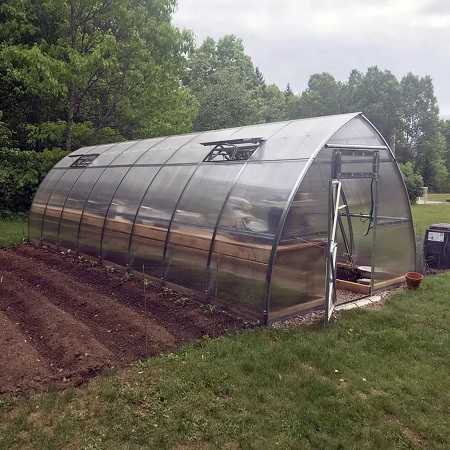
The history of flat arch greenhouses can be traced back to the 19th century. The idea behind this type of greenhouse was to create a structure that was strong and efficient while still allowing sunlight to penetrate the interior.
One of the first flat arch greenhouses was designed by the French horticulturist, Jules Charles. Charles’ greenhouse had a flat arch design with a double-glazed roof that allowed for better insulation and reduced heat loss. The design was a significant improvement over the traditional glasshouse design, which often had a steeply pitched roof that could result in heat loss and poor ventilation.
In the early 20th century, the flat arch greenhouse design was further refined by Dutch horticulturists who developed the Venlo greenhouse. The Venlo greenhouse had a modular design, with standard-sized bays that could be easily joined together to create larger structures. This design allowed for greater flexibility in greenhouse construction and made it easier to customize the size and shape of a greenhouse to suit specific needs.
Today, flat arch greenhouses remain popular due to their energy efficiency and versatility. They are commonly used for commercial plant production, as well as for research and educational purposes. Advances in greenhouse technology have made it possible to design flat arch greenhouses that are highly automated and capable of maintaining optimal growing conditions for plants.
5 Advantages of Flat Arch Greenhouses
Improved Insulation
Flat arch greenhouses have a double-glazed roof that helps to trap heat and keep the interior warm. This reduces the amount of energy needed to heat the greenhouse, which can save money on heating costs.
Better Ventilation
The flat arch design allows for better natural ventilation, which helps to regulate temperature and humidity levels inside the greenhouse. This can be particularly important during the summer months when temperatures can become very hot.
Increased Growing Space
The flat arch design allows for more efficient use of growing space, as it eliminates the need for interior supporting structures that can take up valuable space. This makes it possible to maximize the available growing area and increase the number of plants that can be grown.
Modular Design
Many flat arch greenhouses are designed with a modular structure, which means they can be easily expanded or modified as needed. This makes it possible to scale up or down depending on changing needs, without the need for major structural changes.
Improved Crop Quality
The even distribution of light and heat within a flat arch greenhouse can lead to improved crop quality and yield. Plants receive more consistent levels of light and warmth, which can help to promote healthy growth and increase productivity.
5 Disadvantages of Flat Arch Greenhouses
Cost
Flat arch greenhouses can be more expensive to construct than traditional greenhouse designs due to their more complex structure and the use of specialized materials.
Snow Accumulation
The flat arch design of these greenhouses can make them more susceptible to snow accumulation, particularly in areas with heavy snowfall. This can put stress on the structure and require additional maintenance to ensure that the greenhouse remains safe and functional.
Height Restrictions
Because of their low-profile design, flat arch greenhouses may not be suitable for growing taller plants or crops that require a lot of vertical space.
Limited Headroom
The low-profile design of flat arch greenhouses can also limit headroom, which can make it more difficult to work inside the greenhouse and may require growers to stoop or crouch while tending to plants.
Maintenance
The design of flat arch greenhouses can make them more difficult to maintain, particularly when it comes to cleaning the roof and replacing damaged panels.
6 Fun Facts About Flat Arch Greenhouses
The flat arch design is also known as the “Wageningen greenhouse” or the “Dutch Venlo greenhouse”, after the city of Wageningen in the Netherlands where it was first developed.
The flat arch design was created in the early 20th century to improve upon the traditional glasshouse design, which had a steeply pitched roof that was less efficient and more prone to damage.
The double-glazed roof of flat arch greenhouses can help to trap heat and reduce energy costs by up to 40%.
Flat arch greenhouses are commonly used for commercial plant production, particularly for growing high-value crops such as flowers, vegetables, and herbs.
Flat arch greenhouses are often used for research and educational purposes, as they provide a controlled environment for studying plant growth and development.
The Netherlands is home to some of the largest flat arch greenhouses in the world, with some covering over 100 hectares of land.
In addition to their use in agriculture, flat arch greenhouses are also being explored as a way to provide sustainable housing solutions in urban areas.
Related Articles & Free Email Newsletter Sign Up
Gothic Style Greenhouses Add a Touch of Historical Beauty to a Property
How to Build a Portable Greenhouse Hydroponics System



Comment here